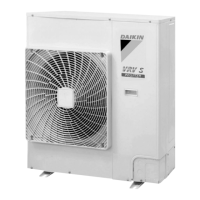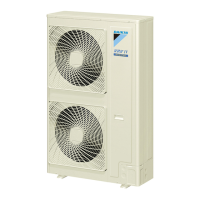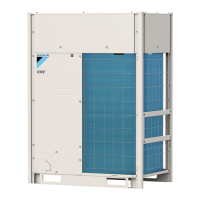16 | Special requirements for R32 units
Installer and user reference guide
74
RXYSA8~12AMY1B
VRV 5-S system air conditioner
4P752782-1A – 2024.02
(a)
One indoor unit connected to a single branch pipe port.
(b)
Two to five indoor units connected to a single branch pipe port, 40m after first refrigerant
branch.
(c)
Two to five indoor units connected to a single branch pipe port, 90m after first refrigerant
branch (size-up of liquid pipe, see "18.1Preparing refrigerant piping"[487]).
Notes:
▪ The values in the table are under the assumption of worst case indoor unit
volume and 40m piping between indoor and SV unit and an installation height
between 1.8m and 2.2m (bottom of indoor unit or bottom of duct openings). In
VRV Xpress it is possible to add custom piping lengths, installation heights above
2.2 m and custom indoor units which can lead to lower minimum room area
requirements.
▪ In case the capacity class allowed per branch pipe port is bigger than 140, use
SV1A unit or combine two ports while using SV4~8A. For more information and
installation of the SV unit, please refer to the installation and operation manual
delivered with the SV unit.
▪ In case multiple indoor units are connected to the same branch pipe port, the
sum of the connected indoor unit capacity classes needs to be equal or less than
the value indicated in the table.
▪ In case indoor units connected to the same branch pipe port are split over
different rooms, the area of the smallest room needs to be considered.
▪ Round down the derived values.
Step 3 – The total indoor capacity connected to a branch pipe port (or pair of
branch pipe ports in case of FXMA200/250) MUST be equal or less than the
capacity limit that is derived from the table.
If NOT, change the installation and repeat all of the above steps.
Possible changes:
▪ Increase the area of smallest room (installed & conditioned) connected to the
same branch pipe port.
▪ Reduce the indoor capacity connected to the same branch pipe port to equal or
below the limit.
▪ Split indoor capacity over two separate branch pipe ports.
▪ Fine tune system with more detailed calculations in VRV Xpress.
Example
VRV system serving three rooms via one SV unit. Room1 (20m²) is served by one
indoor unit (32class) connected to portA. Room2 (42m²) is served by two indoor
units (2×50 class) connected to port B (no extension and liquid pipe size up has
been done). Room3 (150m²) is served by one indoor unit (200class) connected to
portsC and D.
PortA is connected to an indoor unit installed in room1a, that is serving a different
room (room 1b) than where it is installed. The smallest room size needs to be
considered: 20m². Use the table under Step2 to find the maximum capacity class
limit of the indoor unit: 140. The selected indoor unit is 32 →OK.
Port B only serves room 2: use the table under Step 2 to find the maximum
capacity class limit of the sum of the indoor units. 42m² is rounded down to 40m²:
200. The sum of both indoor units is exactly 100 →OK.
PortsC and D are combined and must be considered as one branch pipe. They only
serve room3: Use the table under Step2 to find the maximum capacity class limit
of the indoor unit: 250. The selected indoor unit is 200 →OK.

